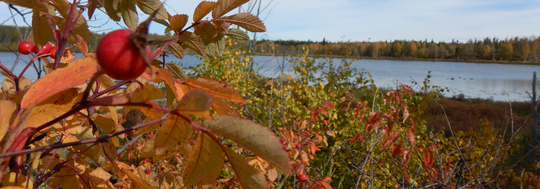History of the Beaver Hills: An Indigenous Perspective

By Bob Montgomery, Indigenous Engagement Coordinator
“It’s sort of in the middle of nowhere,” is a way people often refer to uninhabited and out of the way places. What is unconsciously implied is that there aren’t stories there but what it usually means is that we don’t know or haven’t heard those stories…yet.
The Beaver Hills Biosphere might seem like a middle of nowhere kind of place to people who haven’t been there but it is rich with stories. Cree scholar and educator, Dwayne Donald, uses the metaphor of pentimento - the visual traces of an earlier painting underneath new layers of paint - as a way of describing the stories that overlap on a landscape. We know there is something underneath, but aren’t sure what.
With the recession of glaciers approximately 5000 years ago, the Beaver Hills began to host the unique boreal vegetation that we are familiar with today (MacDonald, 2009). Human migration into the area actually predates this vegetation to between 8000-12000 years ago in seasonal cycles and based on need (ibid). However, evidence of the Blackfoot, Cree and Nakota peoples are said to have been present on these landscapes more permanently after the receding of the glaciers.
Due to the Beaver Hills proximity to the shores of Edmonton Lake (caused by glacial melt) the area was especially attractive to large mammals and, combined with the lush vegetation, the Beaver Hills became a central location for Indigenous Nations (MacDonald, 2009). Evidence of bison pounds (corral type landscape features that bison would be herded into and harvested) found by archeologists suggest the steady food source of bison meat as well as other small game and flora that allowed more permanent settlement in the area. Because food was so plentiful it was easy to share territory in contrast to clear Treaty boundaries we know today.
These archeological findings are confirmed through Indigenous oral histories; a significant and unique form of knowledge that is inaccessible to most non-Indigenous people. Matters and Hood (2016) interviewed Indigenous knowledge holders and Elders to learn about the shared history between Indigenous Nations in the Beaver Hills. These stories offer a history of Nations renegotiating territories however this was not always due to longstanding rivalry. Even Cree and Blackfoot groups who are often thought of as opposing one another would have shared space and resources in the Beaver Hills (Matters & Hood, 2016). GIS software was used to locate First Nations and Métis sites in the Beaver Hills whose stories have been ‘painted over.’
Due to the dislocation of Indigenous Peoples from their territories during intense European settlement of the area, much is missing from these oral histories and connections must be rebuilt for the stories to be reclaimed and shared. A Métis resident explained that early Irish settlers to the area found large balls of unknown origin that turned out to be caches of pemmican for weary traders to sustain themselves in the Beaver Hills. There is so much to unearth beneath the brushstrokes of the stories we tell, uncovering these stories will be delicate work that brings us closer to each other as neighbours.